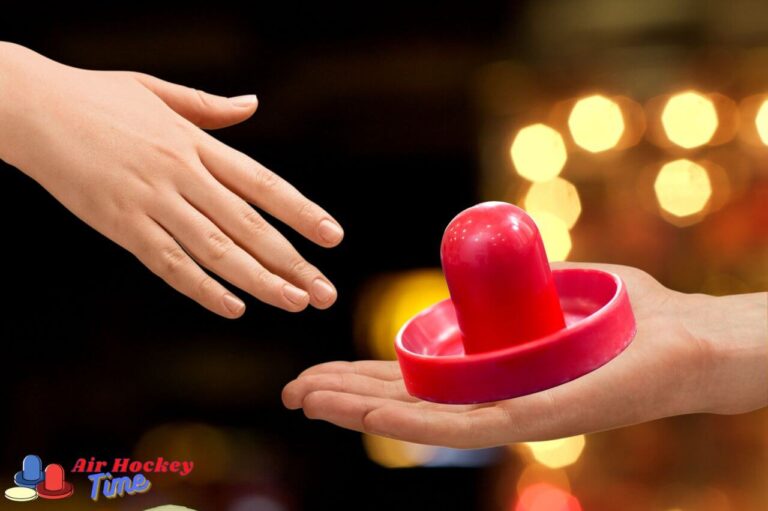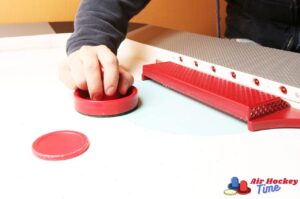Air hockey, a thrilling and fast-paced game, captivates players with its intense gameplay and lightning-fast movements.
One common question is whether players can use their hands during the game.
This discussion will delve into the rules and regulations surrounding hand usage in air hockey.
Understanding the boundaries of hand involvement is crucial for fair play and maintaining the integrity of the game.
So, let’s explore the intriguing world of air hockey and unravel the guidelines regarding hand usage, shedding light on how players can effectively navigate the game while adhering to the rules.

Introducing the Basics of Air Hockey
Air hockey is an exhilarating arcade-style game that has captured the hearts of players worldwide.
Played on a specially designed table, the game combines skill, precision, and lightning-fast reflexes.
The objective is simple: use a handheld mallet to strike a lightweight puck into the opponent’s goal while defending your own.
What sets air hockey apart is the innovative use of an air blower beneath the playing surface, creating a frictionless air cushion.
This allows the puck to glide effortlessly, adding an element of speed and excitement to the game.
Players must possess quick reflexes, hand-eye coordination, and strategic thinking to outmaneuver their opponents and score goals.
Whether played casually with friends or in competitive tournaments, air hockey offers a thrilling experience that keeps players on the edge of their seats.
So, let’s explore the intricacies of air hockey and discover the strategies, techniques, and joy of mastering this dynamic game.
What Is a Goal and How Do You Score in Air Hockey?
In the fast-paced game of air hockey, understanding the concept of a goal and how to score is fundamental to success.
A goal in air hockey refers to successfully propelling the puck into the opponent’s designated scoring area.
Each player defends their goal while trying to score in their opponent’s goal.
Players must skillfully maneuver the puck past the opponent’s defense and into the goal using handheld mallets to score a point.
Timing, accuracy, and strategic positioning are critical factors in scoring goals.
Whether through powerful shots, deflections, or well-placed bank shots, players aim to outwit their opponents and secure points.
The first player to reach a predetermined score, often determined by the number of rounds played, emerges as the victor.
Mastering the art of scoring goals in air hockey requires a combination of quick reflexes, precision, and the ability to adapt to the game’s dynamic nature.
So, get ready to unleash your skills and experience the thrill of scoring in this electrifying air hockey game.
Are There Any Rules That Regulate the Use of Hands in Air Hockey?
In the exhilarating game of air hockey, specific rules regulate the use of hands.
One such scenario arises when a player takes a shot and accidentally drops their mallet just as the puck enters their own goal.
Surprisingly, the point is still valid if this happens without the opponent’s interference or defensive shot.
Players can use their hands to stop the puck in this unique situation.
This rule recognizes the unintentional nature of the drop and allows players to prevent further goals from being scored against them.
It adds an element of fairness and ensures that accidental mallet drops do not solely determine the game’s outcome.
So, while hand usage is generally restricted in air hockey, this circumstance allows players to use their hands to rectify an accidental self-goal and maintain a competitive balance.
Tips for Successfully Using Your Hand During a Game of Air Hockey
While the primary tool in air hockey is the handheld mallet, there are instances where using your hand can be advantageous.
Here are some tips to maximize hand usage during air hockey.
Firstly, timing is crucial.
Learn to anticipate the puck’s movement and position your hand to intercept it at the opportune moment.
Quick reflexes and hand-eye coordination are essential in successfully blocking or redirecting the puck.
Secondly, positioning is critical.
Keep your hand close to the surface, parallel to the goal, and ready to react swiftly.
Maintaining a low profile minimizes the risk of unintentional deflections and maximizes your control over the puck’s trajectory.
Additionally, practice controlling the puck with your hand without impeding its movement excessively.
Gentle taps and subtle adjustments can guide the puck strategically without triggering penalties. Lastly, remember to stay within the boundaries of the rules.
While using your hand is allowed in specific situations, avoid grabbing, holding, or obstructing the puck, which may lead to penalties.
By mastering the art of using your hand effectively, you can add another dimension to your air hockey game, surprising opponents and gaining an edge when it matters most.
What Other Techniques Should You Be Aware Of When Playing Air Hockey?
When it comes to playing air hockey, there are several techniques that players should be aware of to enhance their skills and increase their chances of success.
First and foremost, mastering the art of defense is crucial.
Learning to block and intercept your opponent’s shots requires quick reflexes, anticipation, and precise hand movements.
A solid defensive strategy can frustrate your opponent and create opportunities for counterattacks.
Additionally, honing your offensive techniques is essential.
Experiment with different shot types, such as straight shots, bank shots, and deflections, to keep your opponent guessing and increase your scoring potential.
Developing a solid wrist flick and maintaining a proper stance and grip on the mallet will improve your accuracy and power.
Strategic positioning is another critical aspect to consider.
You can effectively defend and launch counterattacks by strategically positioning yourself closer to your goal or the centerline.
Finally, maintaining focus and concentration throughout the game is crucial. Avoid distractions, keep your eyes on the puck, and stay mentally engaged to make split-second decisions and react quickly to changing game situations.
Combining these techniques and continuously practicing, you can elevate your air hockey game to new heights and become a formidable opponent.
Frequently asked questions
Can you lift the mallet in air hockey?
In the air hockey game, it is essential to note that lifting the mallet and placing it on top of the puck, also known as “topping,” is strictly prohibited.
This action, whether attempted before or after a serve during play, is considered a violation. Topping the puck in such a manner is not allowed at any point in the game, and engaging in this action will result in a foul.
The rule is in place to maintain fair play and prevent players from gaining an unfair advantage by manipulating the puck with their mallets.
Adhering to the rules and avoiding any attempts to lift or top the puck ensures a level playing field and promotes the integrity of the game.
What type of game is air hockey?
Air hockey is an exciting tabletop sport that can be likened to the classic game of Pong. Combining skill, strategy, and quick reflexes, air hockey provides a thrilling and fast-paced experience for players of all ages.
Played on a specially designed table with an air cushion, the objective is to strike a puck into the opponent’s goal using a handheld mallet.
Like, Pong, the game involves back-and-forth exchanges, where players aim to outmaneuver their opponents by anticipating their moves and delivering quick and accurate shots.
The dynamic nature of air hockey, coupled with the element of air cushion that adds an extra challenge, makes it a highly engaging and addictive game.
Whether played casually for fun or in competitive tournaments, air hockey offers a unique and enjoyable gaming experience that keeps players returning for more.
In conclusion
Whether you can use your hand in air hockey has been explored, shedding light on the rules and guidelines surrounding hand usage.
While the primary tool remains the handheld mallet, there are specific situations where the use of hands is permitted, such as stopping the puck after an accidental mallet drop.
However, it is essential to remember that hand usage should be within the boundaries of the rules, avoiding obstruction or manipulation of the puck.
Understanding the nuances of hand involvement can provide players with additional defensive and strategic options during gameplay.
With proper timing, positioning, and control, utilizing your hand effectively can become a valuable asset in your air hockey repertoire.
Whether intercepting shots or guiding the puck precisely, incorporating hand techniques alongside mallet skills can elevate your performance on the air hockey table.
So, embrace the rules, practice your techniques, and enjoy the exhilarating experience of playing air hockey, knowing that your hands can play a role in your quest for victory.








